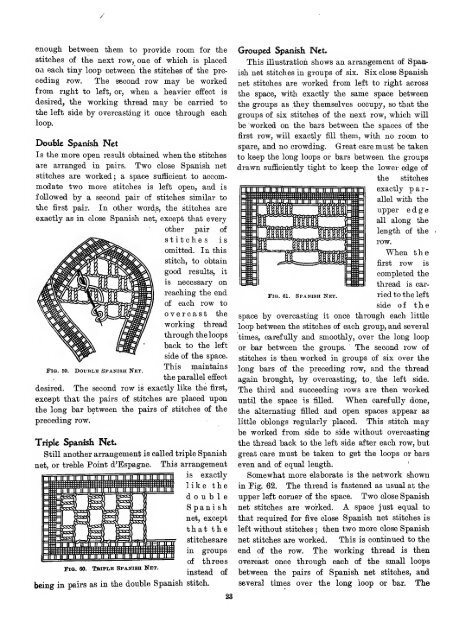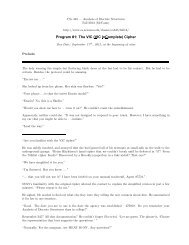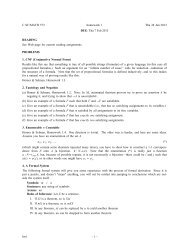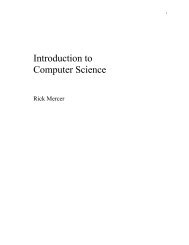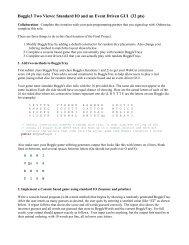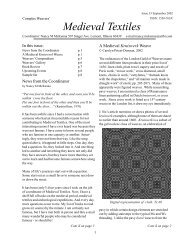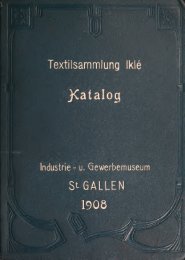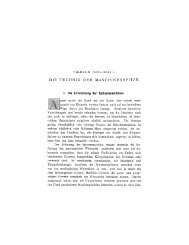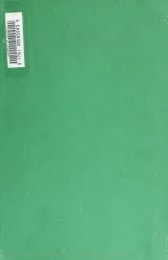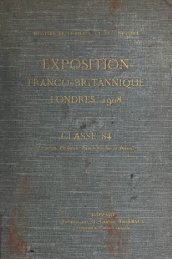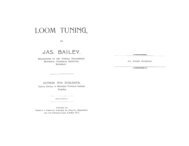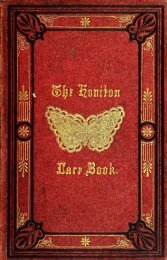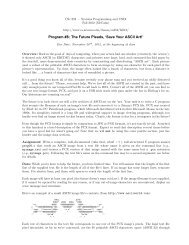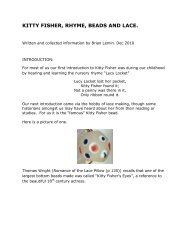The Priscilla Battenberg and point lace book; a collection of lace ...
The Priscilla Battenberg and point lace book; a collection of lace ...
The Priscilla Battenberg and point lace book; a collection of lace ...
You also want an ePaper? Increase the reach of your titles
YUMPU automatically turns print PDFs into web optimized ePapers that Google loves.
enough bet-ween them to provide room for the<br />
stitches <strong>of</strong> the next row, one <strong>of</strong> which is p<strong>lace</strong>d<br />
on each tiny loop oetween the stitches <strong>of</strong> the pre-<br />
ceding TOW. <strong>The</strong> second row may be worked<br />
from right to left, or, when a heavier effect is<br />
desired, the working thread may be carried to<br />
the left side by overcasting it once through each<br />
loop.<br />
Double Spanish Net<br />
Is the more open result obtained when the stitches<br />
are arranged in pairs. Two close Spanish net<br />
stitches are worked ; a space sufficient to accommodate<br />
two more stitches is left open, <strong>and</strong> is<br />
followed by a second pair <strong>of</strong> stitches similar to<br />
the first pair. In other words, the stitches are<br />
exactly as in close Spanish net, except that every<br />
Fis. 59. Double Spanish Net.<br />
other pair <strong>of</strong><br />
stitches is<br />
omitted. In this<br />
stitch, to obtain<br />
good results, it<br />
is necessary on<br />
reaching the end<br />
<strong>of</strong> each row to<br />
overcast the<br />
working thread<br />
through the loops<br />
back to the left<br />
side <strong>of</strong> the space.<br />
This maintains<br />
the parallel effect<br />
desired. <strong>The</strong> second row is exactly like the first,<br />
except that the pairs <strong>of</strong> stitches are p<strong>lace</strong>d upon<br />
the long bar between the pairs <strong>of</strong> stitches <strong>of</strong> the<br />
preceding row.<br />
Triple Spanish Net.<br />
Still another arrangement is called triple Spanish<br />
net, or treble Point d'Espagne. This arrangement<br />
FIG. 60. TBIPLB SPA^SH NET.<br />
is exactly<br />
like the<br />
double<br />
Spanish<br />
net, except<br />
that the<br />
stitchesare<br />
in groups<br />
<strong>of</strong> threes<br />
.^^^^^^ ^j<br />
being in pairs as in the double Spanish stitch.<br />
Grouped Spanish Net.<br />
This illustration shows an arrangement <strong>of</strong> Span-<br />
ish net stitches in groups <strong>of</strong> six. Six close Spanish<br />
net stitches are worked from left to right across<br />
the space, with exactly the same space between<br />
the groups as they themselves occupy, so that the<br />
groups <strong>of</strong> six stitches <strong>of</strong> the next row, which will<br />
be worked on the bars between the spaces <strong>of</strong> the<br />
first row, will exactly fill them, with no room to<br />
spare, <strong>and</strong> no crowding. Great care must be taken<br />
to keep the long loops or bars between the groups<br />
drawn suf&ciently tight to keep the lower edge <strong>of</strong><br />
Biff<br />
' UUOUL<br />
Fig. 61. Spanish Net.<br />
the stitches<br />
exactly par-<br />
allel with the<br />
upper edge<br />
all along the<br />
length <strong>of</strong> the<br />
row.<br />
When the<br />
first row is<br />
completed the<br />
thread is car-<br />
ried to the left<br />
side <strong>of</strong> the<br />
space by overcasting it once through each little<br />
loop between the stitches <strong>of</strong> each group, <strong>and</strong> several<br />
times, carefully <strong>and</strong> smoothly, over the long loop<br />
or bar between the groups. <strong>The</strong> second row <strong>of</strong><br />
stitches is then worked in groups <strong>of</strong> six over the<br />
long bars <strong>of</strong> the preceding row, <strong>and</strong> the thread<br />
again brought, by overcasting, to_ the left side.<br />
<strong>The</strong> third <strong>and</strong> succeeding rows are then worked<br />
until the space is filled. When careftdly done,<br />
the alternating filled <strong>and</strong> open spaces appear as<br />
little oblongs regularly p<strong>lace</strong>d. This stitch may<br />
be worked from side to side without overcasting<br />
the thread back to the left side after each row, but<br />
great care must be taken to get the loops or bars<br />
even <strong>and</strong> <strong>of</strong> equal length.<br />
'<br />
Somewhat more elaborate is the network shown<br />
in Fig. 62. <strong>The</strong> thread is fastened as usual at the<br />
upper left comer <strong>of</strong> the space. Two close Spanish<br />
net stitches are worked. A space just equal to<br />
that required for five close Spanish net stitches is<br />
left without stitches ; then two more close Spanish<br />
net stitches are worked. This is continued to the<br />
end <strong>of</strong> the row. <strong>The</strong> working thread is then<br />
overcast once through each <strong>of</strong> the small loops<br />
between the pairs <strong>of</strong> Spanish net stitches, <strong>and</strong><br />
several times over the long loop or bar. <strong>The</strong>


